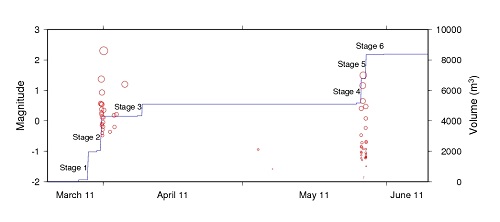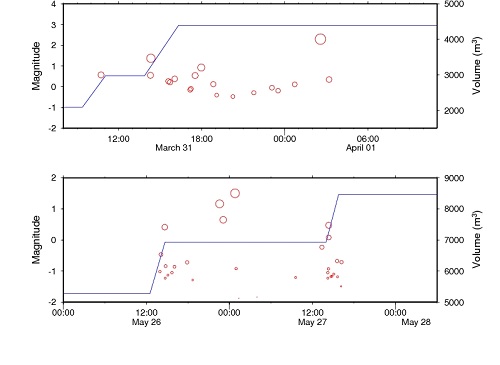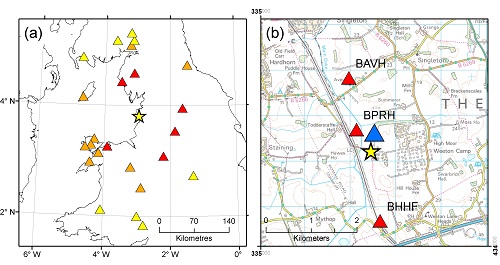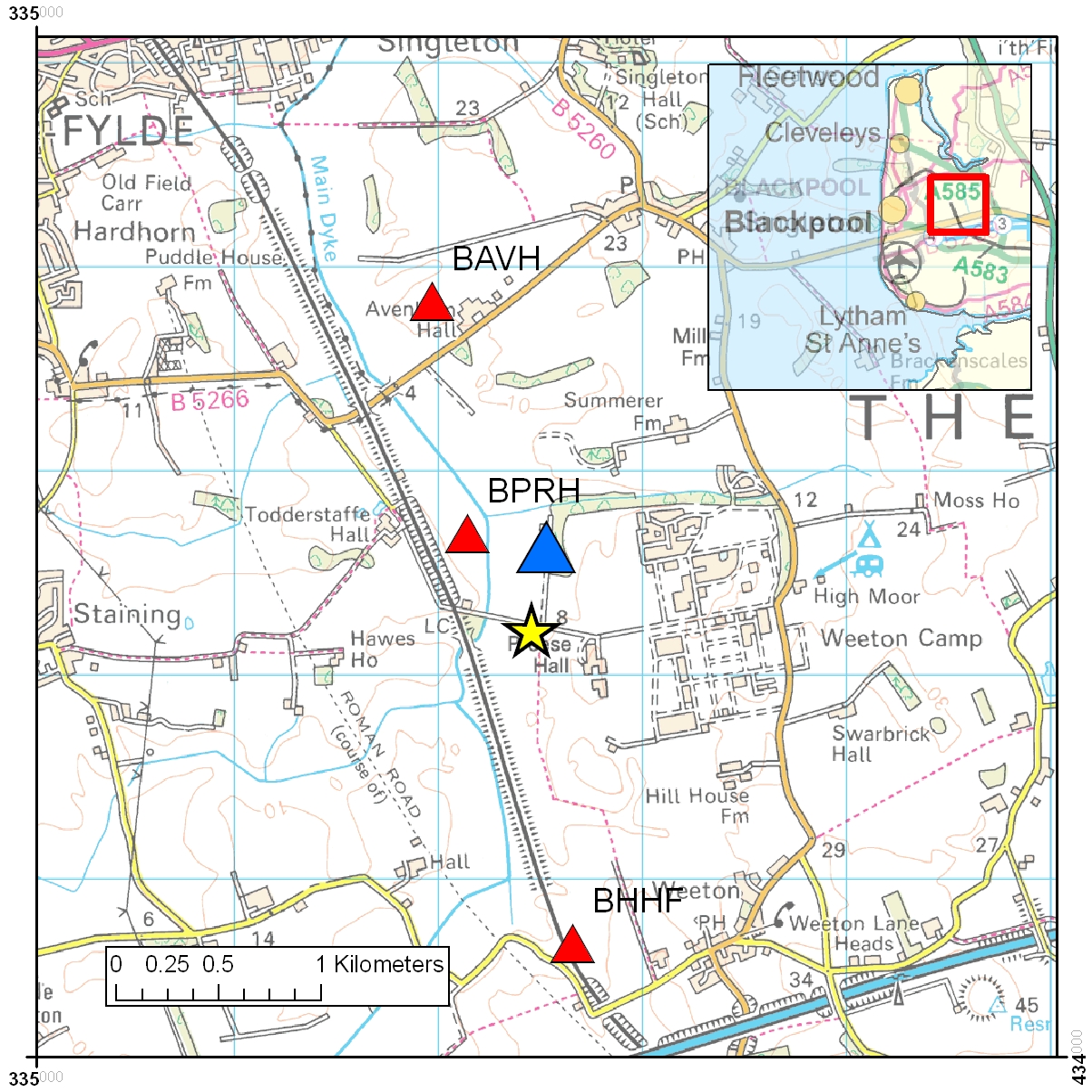Earthquakes induced by Hydraulic Fracturing Operations near Blackpool, UK
In Lancashire, UK, 58 earthquakes were linked to fluid injection during hydraulic fracturing at the Preese Hall well in 2011 (de Pater and Baisch, 2011). The largest, on 1 April 2011, had a magnitude of 2.3 and was felt locally. These hydraulic fracture treatments were carried out during exploration of a shale gas reservoir in the Bowland basin, Lancashire. A further magnitude 1.5 ML earthquake was felt on 27 May, 2011 and also linked to hydraulic fracture treatments, leading to the suspension of operations at Preese Hall.
The unusual seismicity led to a number of detailed studies of the relationship between the earthquakes and hydraulic fracturing operations (for example, de Pater and Baisch 2011; Eisner et al., 2011). In total, 58 earthquakes were detected in the time period between 31 March and 30 August 2011, nearly all of these either during or within a few hours of fracturing operations at Preese Hall. De Pater and Baisch (2011) concluded that the earthquake activity was caused by fluid injection directly into a nearby fault zone, which reduced the effective normal stress on the fault and caused it to fail repeatedly in a series of small earthquakes. A possible causative fault was later identified following a detailed 3-D seismic reflection study (Clarke et al, 2014).
Correlation between earthquakes and injected volume

Earthquake occurence strongly correlates with the injection of fluid during and immediately after hydraulic fracture stages 2, 4 and 5, in which the largest amount of fluid was injected. In two of the hydraulic fracture treatments, stages 2 and 4, the largest earthquakes occurred approximately ten hours after the start of injection, while the well was shut-in under high pressure. These events were preceded by smaller events, which started immediately after injection, the largest of which was a magnitude 1.4 ML event on 31 March.
No seismicity was observed during stages 1 and 3, and only very weak seismicity occurred during stage 5. The lack of seismicity in stage 3 can be attributed to the smaller pumped volume and aggressive flowback. The pumped volume in stage 5 was similar to stages 2 and 4, but there was also flowback, which could explain the lack of larger events. The results show that injected volume and flowback timing are an important controlling factor in the level of seismicity, as evidenced from the lack of seismicity during and after stage 3, suggesting that seismicity can be mitigated by modifying job procedure.

Seismicity began close to the start of injection during stages 2, 4 and 5. This continued throughout injection, and, in the case of stages 2 and 5 for several hours after shut-in. The largest earthquakes occurred approximately ten hours after shut-in, when earthquakes with magnitudes of 2.3 ML and 1.5 ML were observed following stages 2 and 5 respectively. Very few earthquakes were detected following these two events. The lack of seismicity during stage 3 can perhaps be explained by the reduced injection volume and the use of flowback. The use of flowback may also explain the relatively weak seismicity observed during stage 5. The reason for the lack of seismicity during stage 1 is unclear.
Earthquake Locations
Locations for the Blackpool earthquakes were determined by Eisner et al. (2011) and Clarke et al (2013) among others. Similarity between the recorded events suggested that all the events were from the same location and had the same mechanism. It is clear that the location is less than 0.5 km from the well head. In addition, the depths of 3.6 km and 2.9 km, estimated by Eisner et al. (2011) and Clarke et al (2013) are close to the point of injection (2.3 to 2.7 km)for all 6 stages.

Is the Earthquake Activity at Preese Hall Unique
It is relatively well-known that anthropogenic activity can result in man-made or "induced" earthquakes. Although such events are generally small in comparison to natural earthquakes, they are often perceptible at the surface and some have been quite large. Underground mining, deep artificial water reservoirs, oil and gas extraction, geothermal power generation and waste disposal have all resulted in cases of induced seismicity. Davies et al (2013) presented a review of published examples of earthquakes induced by a variety of activities. There are numerous examples of induced earthquakes in hydrocarbon fields related to oil and gas production (e.g. SUCKALE, 2010). These are often a response to long-term production, where the extraction related subsidence is compensated by, for example, normal faulting on existing faults near or inside the reservoir (Van Eijs et al., 2006). For example, in 2001 a magnitude 4.1 Mw earthquake occurred in the Ekofisk field in the central North Sea (Ottemoller et al., 2005). The earthquake was thought to be related to the injection of around 1.9x106 m3 of water.
Induced earthquakes with magnitudes as large as 3.5-4.0 ML are well documented in Enhanced Geothermal Systems (EGS) (e.g. MAJER ET AL, 2007), in which injected fluids are heated by circulation through a hot fractured region of crystalline rocks and then brought back to the surface for power generation. A series of magnitude 3+ earthquakes induced during an EGS project in Basel, Switzerland resulted in the suspension of the project, which was ultimately abandoned almost 3 years later following further study and risk evaluation after these seismic events (Giardini, 2009).
Earthquakes can also be induced by the injection of brines from oil and gas production into wells that are drilled to dispose of large volumes of waste water over many years (e.g. Frohlich et al, 2011). Induced seismicity caused by long term disposal of large volumes of waste fluid in deep boreholes is suspected to be partially responsible for a significant increase in seismicity rate that has been observed in Eastern North America (Ellsworth, 2013). In addition, several of the largest earthquakes in the U.S. midcontinent in 2011 and 2012 may have been triggered by nearby disposal wells (e.g. Horton, 2012; Kim, 2013), suggesting that wastewater disposal by injection to deep wells poses a significant seismic risk. The largest of these was a magnitude 5.7 event in central Oklahoma that destroyed 14 homes and injured two people (Kerenan et al, 2013).
The process of hydraulic fracturing in order to increase the permeability of reservoir formations and stimulate the recovery of hydrocarbons is generally accompanied by microseismicity, commonly defined as earthquakes with magnitudes of less than 2.0 and too small to be felt. The mechanisms for this are generally well understood.
- Firstly, the injection of fluids under high pressure generates new cracks and fractures in a previously intact rock mass. As these grow and spread they are accompanied by brittle failure of the rock and corresponding microseismic events. These are sometimes referred to as "fracked" events. The size of these "fracked" events is constrained by the energy of the injection process.
- Secondly, both presence of high pressure fluid and the stress perturbation caused by the fluid can change the effective stress on pre-existing faults, causing them to fail. These events are sometimes referred to as "triggered" events. Since small stress perturbations can cause relatively large earthquakes the size of these events depends largely on the amount of stored up elastic strain energy already in the rocks.
The process of hydraulic fracturing appears to pose a low risk of inducing destructive earthquakes. A report by the National Research Council in the U.S., which examined the scale, scope and consequences of seismicity induced during fluid injection and withdrawal related to energy technologies, concluded that the process of hydraulic fracturing a well as presently implemented for shale gas recovery does not pose a high risk for inducing felt seismic events. A review of the risks associated with hydraulic fracturing during shale gas exploration and production by the Royal Society and Royal Academy of Engineering in 2012 concluded that the surface impacts of any seismicity induced by hydraulic fracturing would be negligible. A report commissioned by the Department of Energy and Climate Change in the UK by Green et al (2012) set out a number of recommendations for the mitigation of seismic risk in future hydraulic fracture operations for shale gas. Some of these recommendations were adopted as part of the regulatory framework for future operations.
References
- Clarke, H., Eisner, L., Styles, P. and Turner, P. 2014. Felt seismicity associated with shale gas hydraulic fracturing: The first documented example in Europe, Geophys. Res. Lett., 41, 23, 8308-8314.
- de Pater, H. & Baisch, S. 2011. Geomechanical Study of Bowland Shale Seismicity, Synthesis Report
- Davies, R., Foulger, G., Bindley, A. and Styles, P. (2013), Induced seismicity and hydraulic fracturing for the recovery of hydrocarbons. Marine and Petroleum Geology, 45, 171-185
- Eisner L., Janska E and Matousek P. 2011. Seismic Analysis of the events in the vicinity of the Preese Hall well, Seismik report for Cuadrilla Resources
- Ellsworth, W.L. 2013. Injection-Induced Earthquakes, Science, 341
- Frohlich, C., Hayward C., Stump B. and Potter E. 2011. The Dallas–Fort Worth Earthquake Sequence: October 2008 through May 2009, Bulletin of the Seismological Society of America, 101, 1, 327-340 (2011).
- Giardini, 2009. Geothermal quake risks must be faced, Nature, 462, 848-849
- Green, C.A., Styles, P. and Baptie, B. 2012. Preese Hall Shale Gas Fracturing review and recommendations for induced seismic mitigation report, Report for DECC
- Majer E.L., Baria R, Stark M, Oates S., Bommer J., Smith B. and Asanuma H. 2007. Induced seismicity associated with Enhanced Geothermal Systems, Geothermics, 36, 3, 185-222 (2007)
- Suckale, J. 2010. Moderate-to-large seismicity induced by hydrocarbon production, The Leading Edge, 29, 310-314
- Van Eijs, R.M.H.E., Mulders, F.M.M., Nepveu, M., Kenter, C.J. and Scheffers, B.C., 2006. Correlation between hydrocarbon reservoir properties and induced seismicity in the Netherlands, Environmental Geology, 84, 99-111
- BGS Environmental Baseline Monitoring
- Government guidance on fracking: developing shale oil and gas in the UK
- Royal Society and Royal Academy of Engineering review of the risks associated with hydraulic fracturing during shale gas exploration and production
- National Research Council, 2012. Induced seismicity potential in energy technologies, National Academies Press
- Seismological Research Letters: Special Issue on Injection-Induced Seismicity.
- British Geological Survey Shale Gas Project



